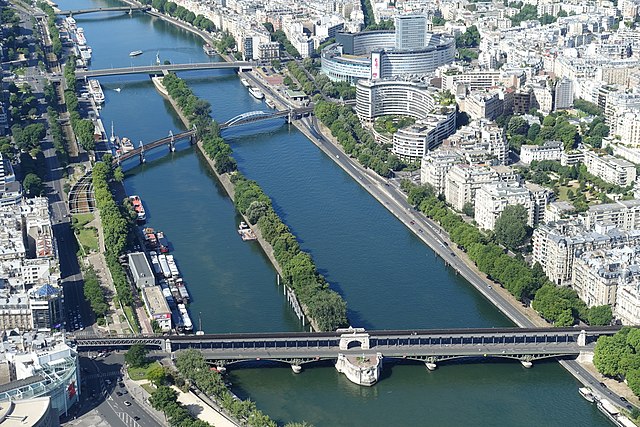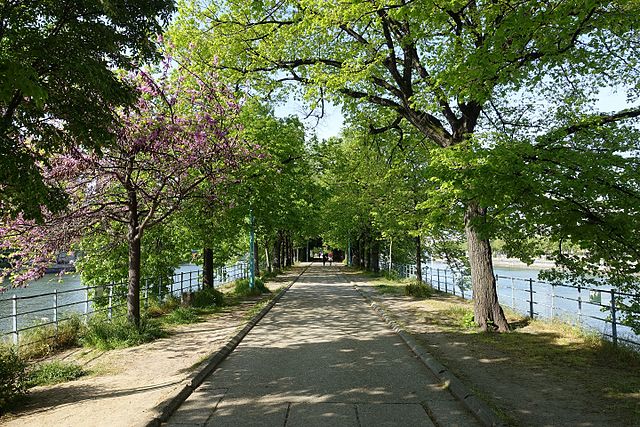Did planners in the mid-20th century forget that Parisians have ears? Last time we looked at a 1960s proposal to build an extensive motorway network inside Paris, bulldozing thousands of homes and destroying a canal in the process. Today’s example of a transport project that never took off is Aéroparis, an aircraft runway just metres from the Eiffel Tower.

The location: the Île aux Cygnes
The Île aux Cygnes – “Swan Island” – is a charming artificial island, 850 m long and 11 m wide, in southwestern Paris, between the 15th and 16th arrondissements. Built in 1825 for the Grenelle river port on the left bank, since 1875 it has hosted a linear park called the Allée des Cygnes. This path, lined with trees and benches, is a peaceful place to stop and enjoy views of the high-rise buildings of the Front de Seine development, the Eiffel Tower, and two of the city’s best bridges, the Pont Rouelle and the Pont de Bir-Hakeim. In 1889, a miniature copy of the Statue of Liberty was installed at one end of the island, marking the centenary of the French Revolution.
The man: André Lurçat
André Lurçat was a founder member, alongside other modernist architects including Le Corbusier and Ernst May, of the CIAM (Congrès internationaux d’architecture moderne), an influential organisation in early-to-mid-20th century architecture. Like others in the modernist movement, he was a communist and believed that architecture could be used to further his political goals. His works in the Île-de-France region include houses for artists in Paris, the Karl Marx school complex in the southern suburb of Villejuif, and a number of social housing estates in Saint-Denis and Le Blanc-Mesnil, north of the capital. Elsewhere, he designed the rebuild of the northern town of Maubeuge, devastated in the Second World War.
The project: Aéroparis
In 1932, Lurçat proposed a plan to build a small airport on the Île aux Cygnes. A runway would be constructed above the level of the bridges, extending beyond the Pont de Bir-Hakeim. Beneath the runway, replacing the Allée des Cygnes, would be the rest of the airport: passenger services and aircraft storage. The size of the runway being incompatible with long-distance aircraft, passengers would transfer at Le Bourget (then Paris’s main airport) onto smaller aeroplanes for the last part of their journey. See here for a mocked-up photo from the time, with the planned runway displayed.

What went wrong?
Looking at the plan with 2020 hindsight, the idea seems utterly impractical for a number of reasons. The runway was already incompatible with most passenger aircraft, and this was before the jet airliner came onto the scene. It would only ever have served a tiny fraction of air passenger traffic, in the process causing massive inconvenience and health issues for the inhabitants of the surrounding areas.
Interestingly, however, it seems it wasn’t noise and air pollution concerns that did for the project. Locals instead appear to have mobilised against the loss of the island’s trees. And while I’m grateful it never went ahead and those trees still line the peaceful path, a small part of me regrets being unable to stand on the iconic Pont de Bir-Hakeim and listen to small planes taking off and landing above my head.
This article is part of a series about the transport that never was in Paris: see below for links to the rest of the series. And Fabric of Paris will keep coming back to stories like these, so make sure to sign up below to receive email updates.
 Fabric of Paris
Fabric of Paris